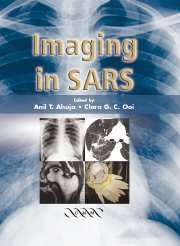Book contents
- Frontmatter
- Contents
- Contributors
- Preface
- 1 The Epidemiology of Severe Acute Respiratory Syndrome: A Global Perspective
- 2 The Role of Emergency Medicine in Screening SARS Patients
- 3 Severe Acute Respiratory Syndrome Outbreak in a University Hospital in Hong Kong
- 4 Imaging of Pneumonias
- 5 The Role of Chest Radiographs in the Diagnosis of SARS
- 6 Chest Radiography: Clinical Correlation and Its Role in the Management of Severe Acute Respiratory Syndrome
- 7 The Role of High-Resolution Computed Tomography in Diagnosis of SARS
- 8 The Role of Imaging in the Follow-up of SARS
- 9 Treatment of Severe Acute Respiratory Syndrome
- 10 SARS in the Intensive Care Unit
- 11 Imaging of Pneumonia in Children
- 12 Imaging and Clinical Management of Paediatric SARS
- 13 Imaging of SARS in North America
- 14 Radiographers' Perspective in the Outbreak of SARS
- 15 Implementation of Measures to Prevent the Spread of SARS in a Radiology Department
- 16 Aftermath of SARS
- 17 Update on Severe Acute Respiratory Syndrome
- Index
8 - The Role of Imaging in the Follow-up of SARS
Published online by Cambridge University Press: 27 October 2009
- Frontmatter
- Contents
- Contributors
- Preface
- 1 The Epidemiology of Severe Acute Respiratory Syndrome: A Global Perspective
- 2 The Role of Emergency Medicine in Screening SARS Patients
- 3 Severe Acute Respiratory Syndrome Outbreak in a University Hospital in Hong Kong
- 4 Imaging of Pneumonias
- 5 The Role of Chest Radiographs in the Diagnosis of SARS
- 6 Chest Radiography: Clinical Correlation and Its Role in the Management of Severe Acute Respiratory Syndrome
- 7 The Role of High-Resolution Computed Tomography in Diagnosis of SARS
- 8 The Role of Imaging in the Follow-up of SARS
- 9 Treatment of Severe Acute Respiratory Syndrome
- 10 SARS in the Intensive Care Unit
- 11 Imaging of Pneumonia in Children
- 12 Imaging and Clinical Management of Paediatric SARS
- 13 Imaging of SARS in North America
- 14 Radiographers' Perspective in the Outbreak of SARS
- 15 Implementation of Measures to Prevent the Spread of SARS in a Radiology Department
- 16 Aftermath of SARS
- 17 Update on Severe Acute Respiratory Syndrome
- Index
Summary
Introduction
Severe acute respiratory syndrome (SARS) has shown itself to be different from most other forms of viral pneumonia in its infectivity, clinical course, predilection for affecting health care workers, and high rates of mortality and morbidity. During the acute phase of the epidemic the imaging characteristics of SARS during the acute phase been investigated, but its post-treatment sequelae are only just becoming apparent as they surface in the imaging of patients attending follow-up. In line with the acute stages of this disease, the recovery also appears to be punctuated with an exaggeration of the host response, with patients developing residual disease or early signs of fibrosis in affected areas of the lungs. With this in mind, the follow-up of these patients will require close clinical and radiological monitoring. This chapter shall present the appearances and role of imaging in the follow-up of SARS.
Follow-up presentation of SARS patients
Follow-up is usually uneventful for most other types of viral pneumonia in adults. However, while a portion of treated and discharged SARS patients may be completely asymptomatic, a significant number have residual symptoms. It has been reported that 46% of discharged patients complained of exertional dyspnoea at 1-month follow-up. This was not restricted to elderly patients but also affected patients in their 30s, resulting in the limitation of their daily activities.
- Type
- Chapter
- Information
- Imaging in SARS , pp. 79 - 88Publisher: Cambridge University PressPrint publication year: 2004

